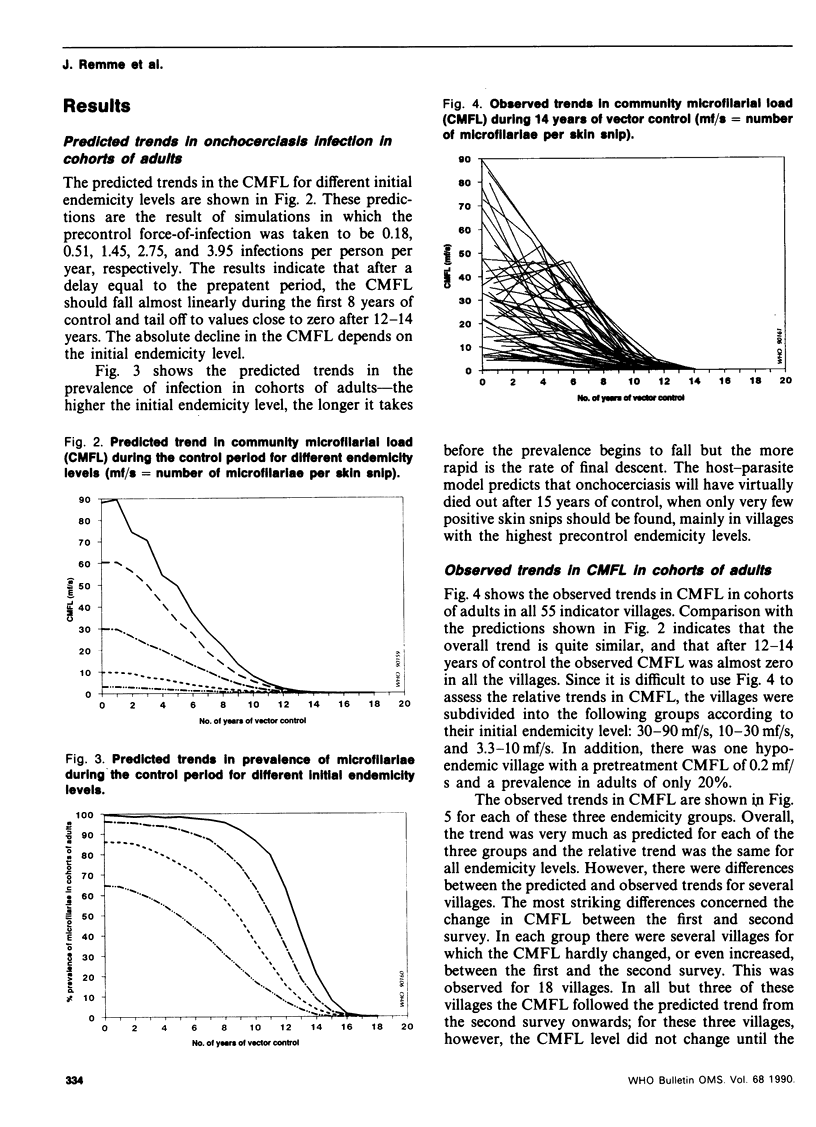Abstract
In 55 villages from the well-protected central area of the Onchocerciasis Control Programme in West Africa (OCP), skin snip surveys have been carried out at regular intervals since the programme started, and the latest round of surveys was undertaken after 12-14 years of successful vector control. The observed trends in the prevalence and intensity of onchocerciasis infection in cohorts of adults were compared with the trends predicted using a host-parasite model. After 12-14 years of control the community microfilarial load (CMFL) was close to zero in all villages. During the last few years of control, the prevalence of infection declined at an accelerated rate, and this was predicted by the model. There was generally good agreement between observed and predicted trends. The predictions were based on an estimated average duration of infection of 10.4 years, which corresponds to a mean reproductive lifespan for Onchocerca volvulus of 9-9.5 years, and an upper limit of 15 years for 95% of the infections. Differences between the observed and predicted data included the trend in CMFL between the first and second surveys, which in 18 villages did not show the predicted decline. Furthermore, the observed final decline in prevalence was faster than predicted in the north-eastern part of the central OCP area. After 14 years of vector control, the level of onchocerciasis has fallen to such a low level that consideration is being given to ending larviciding.
Full text
PDF








Selected References
These references are in PubMed. This may not be the complete list of references from this article.
- Duke B. O. The effects of drugs on Onchocerca volvulus. 1. Methods of assessment, population dynamics of the parasite and the effects of diethylcarbamazine. Bull World Health Organ. 1968;39(2):137–146. [PMC free article] [PubMed] [Google Scholar]
- Habbema J. D., van Oortmarssen G. J., Lubbe J. T., van der Maas P. J. The MISCAN simulation program for the evaluation of screening for disease. Comput Methods Programs Biomed. 1985 May;20(1):79–93. doi: 10.1016/0169-2607(85)90048-3. [DOI] [PubMed] [Google Scholar]
- Karam M., Schulz-Key H., Remme J. Population dynamics of Onchocerca volvulus after 7 to 8 years of vector control in West Africa. Acta Trop. 1987 Dec;44(4):445–457. [PubMed] [Google Scholar]
- Prost A., Prod'hon J. Le diagnostic parasitologique de l'onchocercose. Revue critique des methodes en usage. Med Trop (Mars) 1978 Sep-Oct;38(5):519–532. [PubMed] [Google Scholar]
- Remme J., Ba O., Dadzie K. Y., Karam M. A force-of-infection model for onchocerciasis and its applications in the epidemiological evaluation of the Onchocerciasis Control Programme in the Volta River basin area. Bull World Health Organ. 1986;64(5):667–681. [PMC free article] [PubMed] [Google Scholar]
- Roberts J. M., Neumann E., Göckel C. W., Highton R. B. Onchocerciasis in Kenya 9, 11 and 18 years after elimination of the vector. Bull World Health Organ. 1967;37(2):195–212. [PMC free article] [PubMed] [Google Scholar]


